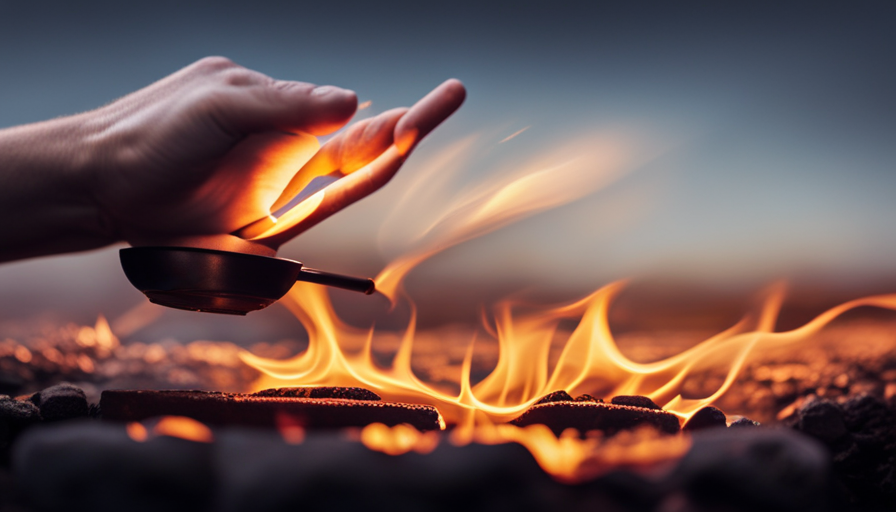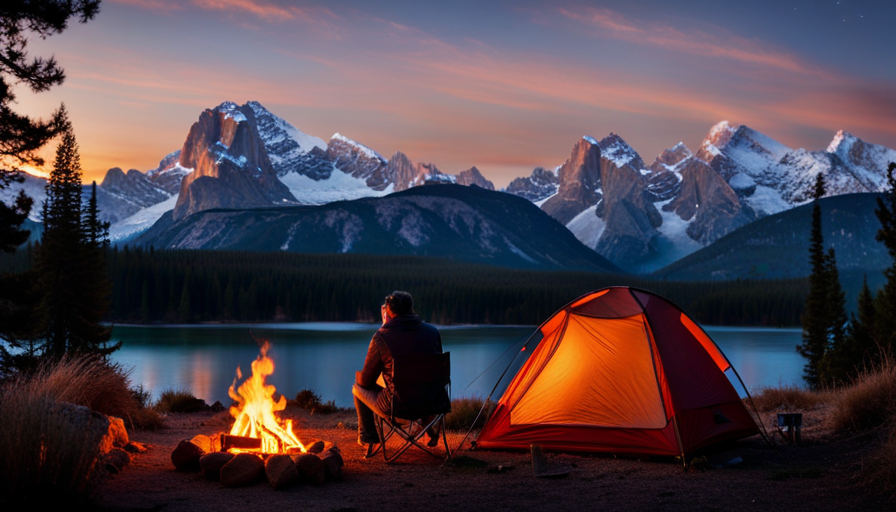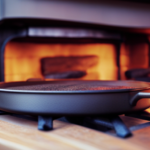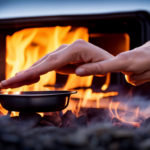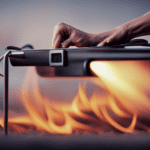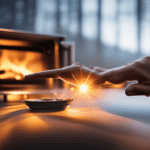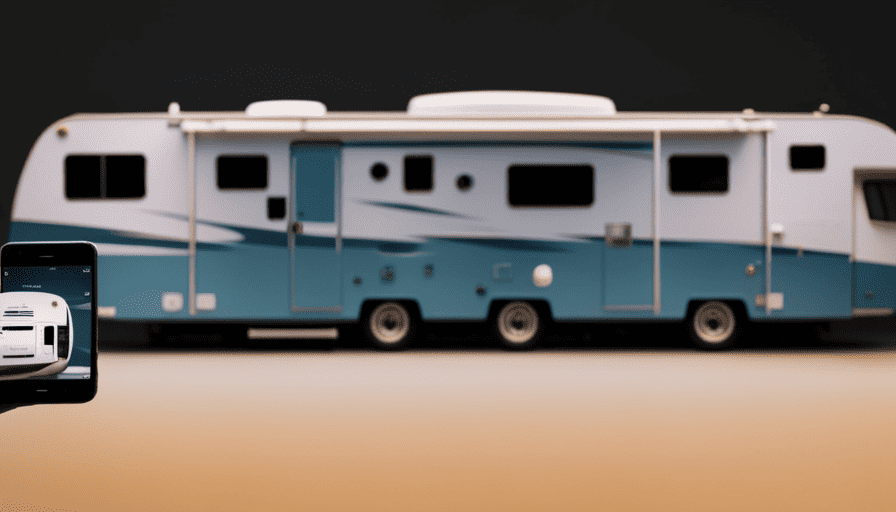There is a well-known saying that goes, “Where there’s a camper, there’s a way.” This holds true when it comes to figuring out how to use the oven in your camper. While it may seem daunting at first, there is no need to fret. With a little bit of knowledge and following some simple steps, you’ll be cooking up tasty meals in no time.
In this article, I’ll guide you through the process of lighting your camper oven, ensuring a safe and efficient experience. From checking for gas leaks to adjusting the temperature and cooking settings, I’ll provide you with all the necessary information to get your oven up and running smoothly.
So, grab your lighter or matches, open the oven door, and let’s dive into the world of camper oven lighting. Get ready to enjoy delicious meals on your next camping adventure!
Key Takeaways
- Check for gas leaks and verify gas pressure before lighting the oven in a camper.
- Locate the pilot light and use electric ignition or manual ignition with a match or lighter.
- Take safety precautions and avoid wearing loose clothing when lighting the oven.
- Adjust the temperature and cooking settings as needed and use the timer function for convenience.
Check for Gas Leaks
Before you start lighting the oven in your camper, make sure to check for any gas leaks to ensure a safe and enjoyable cooking experience! Checking for gas leaks is an essential step in proper oven maintenance.
Gas leaks can be dangerous, as they can lead to explosions or fires. Therefore, it’s crucial to take the time to inspect your camper’s gas system before using the oven.
To check for gas leaks, start by turning off all gas appliances and making sure the gas supply valve is closed. Next, mix a solution of soapy water in a spray bottle. Then, spray the solution onto the gas connections, including the gas line, regulator, and fittings. If you notice any bubbles forming, it indicates a gas leak. If you see any bubbles, it’s important to address the issue before proceeding further.
If you don’t detect any gas leaks, you can proceed to the next step of turning on the gas supply. But before doing so, it’s crucial to ensure that the oven is properly ventilated and that there are no flammable materials nearby.
By following these precautions and checking for gas leaks, you can ensure a safe and enjoyable cooking experience in your camper.
Turn on the Gas Supply
First, make sure you’ve got the gas supply turned on in your camper. This step is crucial before attempting to light the oven. To ensure a safe and successful ignition, follow these important guidelines:
-
Double-check the gas supply valve. Locate it near the oven and make sure it’s in the ‘on’ position. If it’s not, turn it on before proceeding.
-
Inspect the gas hose connection. Make sure it’s securely attached to both the oven and the gas supply. If there are any loose connections, tighten them carefully to avoid gas leaks.
-
Verify the gas pressure. Check the pressure gauge on the gas supply to make sure it’s within the recommended range specified by the manufacturer. If it’s too low or too high, contact a professional for assistance.
-
Test for gas leaks. Apply a mixture of soapy water to the gas connections, including the supply valve, hose, and oven. If you see any bubbles forming, there might be a gas leak. In this case, turn off the gas supply and consult a professional for repairs.
Now that you have the gas supply turned on, the next step is to locate the oven pilot light.
Locate the Oven Pilot Light
To find the oven pilot light, you’ll want to explore the interior of your camper and look for a small flickering flame. The oven pilot light is usually located near the burner, and it’s responsible for igniting the gas that heats up the oven.
There are different ignition methods for pilot lights, such as electric ignition or manual ignition with a match or lighter. If you have an electric ignition, simply turn the oven dial to the desired temperature and the spark should ignite the pilot light automatically. However, if you have a manual ignition, you’ll need to prepare a lighter or matches.
Make sure the gas supply is turned on and then hold the flame near the pilot light while turning the oven dial to the pilot position. Once the pilot light ignites, continue holding the flame for a few seconds to ensure the pilot light stays lit. If the pilot light doesn’t ignite, you may need to troubleshoot by checking if the gas supply is turned on and ensuring there is no blockage in the pilot light or gas line.
Transitioning into the subsequent section about ‘prepare a lighter or matches’, it’s important to have these tools ready in case the pilot light fails to ignite.
Prepare a Lighter or Matches
Now, get your lazy self a lighter or some matches because you never know when that pilot light’s gonna fail on you. When it comes to lighting the oven in your camper, there are a few methods you can use. The most common methods include using a lighter or matches.
Before proceeding with any lighting method, it’s important to ensure that the area around the oven is clean and free from any flammable materials.
To begin, make sure you have a lighter or matches readily available. It’s always a good idea to have a backup in case one fails. When using a lighter, hold it close to the pilot light and press the ignition button. If you’re using matches, strike one and carefully bring it close to the pilot light. Once the pilot light is lit, you’ll need to hold the flame for a few seconds to ensure it stays lit.
Remember to always follow safety measures when lighting the oven. Keep your face and body away from the flame and avoid wearing loose clothing that could catch fire. Additionally, never leave the oven unattended while the pilot light is lit.
With the oven pilot light successfully lit, you can now move on to the next step of opening the oven door. Transitioning into this next section, it’s important to be cautious and take the necessary safety precautions when handling the oven door.
Open the Oven Door
Once the flame is safely ignited, it’s time to unveil the delicious surprises that await behind the oven door. Opening the oven door in a camper requires careful attention to open oven maintenance and camper oven safety. Here are some important steps to follow:
-
Gently grip the handle of the oven door and pull it towards you. As you open the door, be mindful of any hot surfaces or steam that may escape. Use oven mitts or a towel to protect your hands.
-
Take a moment to visually inspect the interior of the oven. Look for any signs of damage or debris that may need to be cleaned before use. Check that the oven racks are properly in place and secure. Adjust them if necessary.
-
Notice the warm aroma of freshly baked goods that fills the air as you open the oven door.
Now that the oven door is open, it’s time to move on to the next step: locating the pilot light button or ignition switch. This will allow you to safely and easily light the oven and begin your culinary adventure.
Locate the Pilot Light Button or Ignition Switch
After opening the oven door, you can easily find the pilot light button or ignition switch to start your culinary adventure, adding a touch of excitement to your camper cooking experience. The location of the pilot light button or ignition switch may vary depending on the make and model of your camper oven. To assist you in troubleshooting pilot light issues and common oven ignition problems, refer to the following table:
| Common Issues | Possible Solutions |
|---|---|
| Pilot light won’t ignite | Ensure the gas supply is turned on. Check for any obstructions in the gas line. |
| Pilot light keeps going out | Clean the pilot light orifice. Adjust the pilot light flame to the recommended height. |
| Ignition switch not working | Check if the switch is properly connected. Replace the ignition switch if necessary. |
By familiarizing yourself with these common problems and their solutions, you can confidently troubleshoot any pilot light or ignition issues that may arise. Now, let’s move on to the next section where we will discuss how to hold the lighter or matches to the pilot light, igniting the flames that will bring your camper oven to life.
Hold the Lighter or Matches to the Pilot Light
After locating the pilot light button or ignition switch in your camper oven, it’s time to move on to the next step: holding the lighter or matches to the pilot light. This is where the actual lighting process begins.
To successfully light the oven, you need to employ proper lighting techniques. Here are a few tips to help you get it right:
- Hold the lighter or matches close to the pilot light. Make sure there’s enough distance between your hand and the flame to avoid any accidents.
- Keep the pilot light button or ignition switch pressed while you ignite the flame. This’ll ensure a continuous flow of gas to the pilot light.
- If the pilot light doesn’t ignite immediately, don’t panic. It could be due to air in the gas line. Simply try again, holding the flame to the pilot light for a few more seconds.
- If you’re using matches, be extra careful when lighting them to avoid any burns.
By following these lighting techniques and troubleshooting the pilot light, you’ll be able to safely ignite your camper oven. Now, let’s move on to the next step: waiting for the pilot light to ignite and stabilize.
Wait for the Pilot Light to Ignite
While patiently waiting, watch as the tiny, flickering flame dances to life, casting a warm glow in the darkness. Igniting the pilot light in your camper’s oven can sometimes be a bit tricky, but with a little troubleshooting and patience, you’ll have it up and running in no time. Let’s explore some common pilot light issues and how to troubleshoot them.
To make it easier for you, I have created a helpful table that outlines the most common ignition troubleshooting techniques. Take a look:
| Issue | Possible Solution |
|---|---|
| Pilot light won’t ignite | Check if gas supply is on and try relighting |
| Flame goes out immediately | Clean the pilot orifice and check for drafts |
| Weak or yellow flame | Adjust the air shutter or clean the burner |
| Pilot light won’t stay lit | Replace the thermocouple or check for gas leaks |
| Pilot light won’t ignite after relighting | Wait a few minutes before relighting again |
By following these troubleshooting techniques, you can easily address any pilot light issues and ensure a successful ignition. Now, let’s move on to the next step and learn how to adjust the temperature and cooking settings for your camper oven.
In the subsequent section, we will explore how to adjust the temperature and cooking settings of your camper oven without any hassle.
Adjust the Temperature and Cooking Settings
To ensure a successful culinary experience, you’ll easily adjust the temperature and cooking settings of your camper oven without any hassle. Here are some tips to help you make the most of your cooking experience:
-
Start by preheating the oven to the desired temperature. This is crucial for achieving even cooking and perfect results.
-
Adjust the temperature according to the recipe requirements. Most camper ovens have a temperature dial that allows you to select the desired heat level.
-
Experiment with different cooking techniques such as baking, broiling, or roasting. Each technique requires specific temperature adjustments, so make sure to read the recipe instructions carefully.
-
Use the oven’s timer function to keep track of cooking times. This will help you avoid undercooked or overcooked meals.
-
Don’t be afraid to make adjustments as you go. Sometimes, certain recipes may require slight temperature modifications to achieve the desired outcome.
Now that you know how to adjust the temperature and cooking settings of your camper oven, it’s time to move on to the next section: safety precautions and tips. It’s important to prioritize safety while using any kind of oven, especially in a camper setting.
Safety Precautions and Tips
Now that we’ve adjusted the temperature and cooking settings on our camper oven, let’s talk about some important safety precautions and tips to keep in mind.
When it comes to camping oven maintenance, regular cleaning is crucial to ensure proper functioning. Before lighting the oven, always check for any debris or food particles that could potentially cause a fire hazard. A quick wipe down with a damp cloth should do the trick.
One of the most common mistakes while lighting an oven in a camper is not properly ventilating the area. It’s important to open a window or door to allow for adequate airflow, as propane can produce carbon monoxide, which is a dangerous gas. Additionally, always double-check that the propane tank is securely connected and in good condition.
Another important safety tip is to never leave the oven unattended while it’s lit. Accidents can happen in the blink of an eye, and it’s better to be safe than sorry. Finally, make sure to have a fire extinguisher nearby, just in case.
By following these safety precautions and tips, you can enjoy delicious meals while camping without any worries.
Now, let’s move on to our next subtopic: cleaning and maintaining the camper oven.
Frequently Asked Questions
How do I check for gas leaks in my camper oven?
Oh, the joys of gas leaks in your camper oven! Let me enlighten you on the art of gas leak detection and prevention.
First, grab a trusty gas leak detector and carefully inspect all the connections and fittings. If you detect even the faintest whiff of gas, it’s time to tighten those loose ends.
To prevent future leaks, make sure to check the connections regularly and never underestimate the power of a good ol’ soapy water solution to reveal those sneaky leaks.
Stay safe, my fellow camper enthusiasts!
What should I do if I smell gas while trying to light the oven?
If I smell gas while trying to light the oven in my camper, I would take immediate action to prevent gas leaks and ensure my safety. First, I would turn off the gas supply immediately.
Then, I would open all windows and doors to ventilate the area. I would avoid using any electrical devices or open flames, and I wouldn’t attempt to light the oven until the smell of gas has dissipated.
Finally, I would contact a professional to inspect and repair the oven before using it again.
Is it necessary to open the oven door before attempting to light the pilot light?
Opening the oven door before attempting to light the pilot light is absolutely necessary. It’s like a breath of fresh air, ensuring proper ventilation and safety.
When lighting the oven in a camper, it’s crucial to understand the gas system. Check the gas supply and regulate the pressure to avoid any mishaps.
Remember, opening windows and doors while lighting the oven not only helps with ventilation but also adds an extra layer of precaution. Stay informed, stay safe.
Can I use a lighter instead of matches to ignite the pilot light?
Yes, you can use a lighter instead of matches to ignite the pilot light. However, it’s important to consider safety considerations when using a lighter. Make sure that the lighter is long enough to reach the pilot light without putting your hand too close to the flame. Additionally, always exercise caution and follow the manufacturer’s instructions when lighting the pilot light to ensure proper ignition and prevent accidents.
Are there any specific safety precautions I should be aware of when lighting the oven in my camper?
When it comes to gas safety and oven maintenance in your camper, there are several important precautions to keep in mind.
First and foremost, always ensure proper ventilation to prevent the buildup of carbon monoxide.
Additionally, regularly inspect the gas lines and connections for any leaks or damage.
It’s also crucial to follow the manufacturer’s instructions for lighting the oven and never leave it unattended while in use.
By taking these precautions, you can enjoy a safe and well-maintained oven in your camper.
Are the Steps to Light the Oven in a Camper the Same as Lighting a Camper Oven?
The steps to lighting a camper oven may vary from those required to light a regular oven. It’s essential to follow the instructions provided by the manufacturer for safe operation. Take your time to understand the specific procedure and ensure you have the necessary tools and resources before attempting to light the camper oven.
Is the Process of Lighting a Camper Stove Similar to Lighting an Oven in a Camper?
When it comes to lighting a camper stove, the process is similar to lighting an oven in a camper. Both appliances require you to carefully light your camper stove using a match or lighter, ensuring that the gas is turned on and then adjusting the flame to the desired level for cooking.
Conclusion
So there you have it, folks! Lighting the oven in your camper is as easy as following a few simple steps. Just remember to always check for gas leaks before starting. Turn on the gas supply and locate the pilot light. Have a lighter or matches handy. With a little patience, you’ll have a roaring flame in no time.
Now you can unleash your inner chef and cook up a storm in your cozy little camper kitchen. Happy cooking, and may your meals be as hot as the desert sun!

